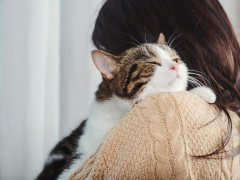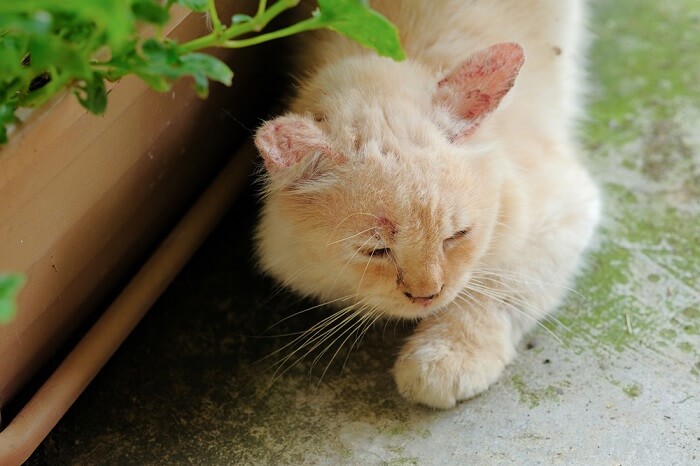
The aim of this article is to provide a simple, clear explanation to help cat owners understand all about fungal infections in cats.
Quick Overview: Fungal Infections in Cats







What Are Fungal Infections?
A number of different pathogens (disease causing agents) can cause infectious diseases in cats:
- Parasites
- Viruses
- Bacteria
- Fungi (the plural of “fungus”)
This article focusses on fungi, which cause fungal infections.
When a cat is affected by a fungal infection, the fungus colonises some part of the cat’s body, engaging with the cat’s immune system, and causing signs of disease. The details depend on which particular fungus, and which part of the cat’s body.
What Type of Fungal Infections Can Affect Cats?
A wide range of fungal infections are possible: here is a comprehensive list of the ones that can affect domestic cats.
- Ringworm, or dermatophytosis (which means fungal infection of the skin, hair and nails). These skin infections can be caused by a number of different types of fungi including microsporum canis. Please see our specific article about ringworm in cats for more details on this specific condition.
- Candidiasis, a fungal infection that can affect the gastrointestinal (GI), respiratory, or urogenital tracts
- Blastomycosis, a systemic disease caused by Blastomyces species of fungus
- Sporotrichosis is a fungal skin or systemic disease caused by Sporothrix species of fungus
- Cryptococcosis is a fungal infection of the respiratory system caused by Cryptococcus neoformans or other species of this fungus. These fungal spores are most often found in bird droppings, especially pigeon feces, but can also be found in decaying vegetation.
- Nasal aspergillosis, a fungal infection of the nasal passages, caused by the Aspergillus fungus
- Phaeohyphomycosis, a specific fungal infection causing cutaneous, subcutaneous, and/or central nervous system (CNS) disease
- Hyalohyphomycosis, which is primarily a rare fungal infection of the skin as well as a number of other parts of the body
- Histoplasmosis , a rare systemic fungal infection
- Coccidioidomycosis, a rare systemic fungal infection
- Keratomycosis, or fungal keratitis, is a fungal infection of the surface of the eye
- Fungal cystitis
- Fungal meningitis
How Common Are Fungal Infections in Cats?
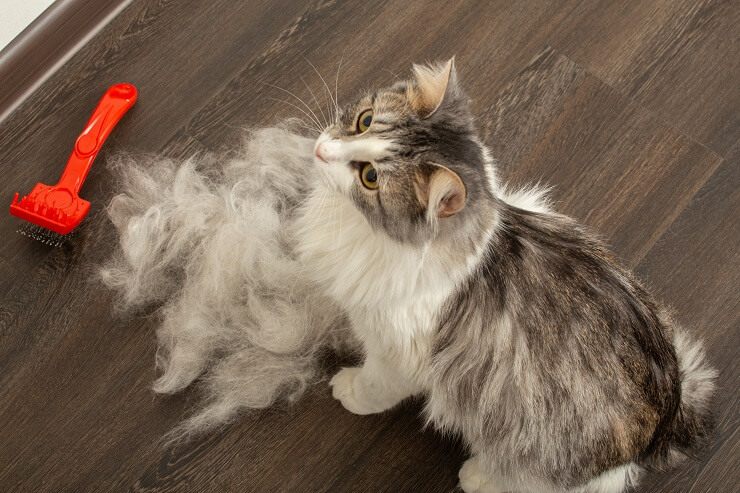
The appropriate treatment for your cat’s hair loss will depend on its underlying cause.
- Ringworm, or dermatophytosis, is very common with a worldwide distribution.
- The other types of fungal infections are only seen rarely. They are more common in some parts of the world, but in general, they are rare diagnoses that veterinarians will bear in mind when investigating cases that have unusual presentations that are not responding to simple treatments.
How Do Cats Get Fungal Infections?
In general, fungal infections tend to spread via the spores (like tiny eggs) that are produced by the fungal organisms. These spores tend to stay in the environment, spreading by fomites (i.e. a cat carrying the fungus will leave spores on an object, and another cat will pick up the fungal infection after direct contact with that object).
Symptoms of Fungal Infections in Cats
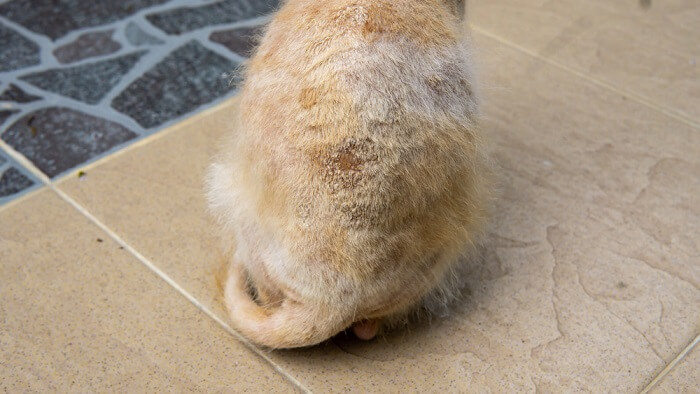
Some fungal infections cause cats to lose hair, and get skin lesions, sometimes circular, sometimes with scales, thickened areas, pigmentation.
The clinical signs of fungal infections vary according to the part of body that’s affected.
- Ringworm, or dermatophytosis causes hair loss, and skin lesions, sometimes circular, sometimes with scales, thickened areas, pigmentation, and other changes.
- Candidiasis, affecting the gastrointestinal (GI), biliary, upper respiratory, or urogenital tracts, tends to cause inflammation of these areas, and grey fungal plaques may be seen.
- Systemic Blastomycosis causes general signs including dullness, weight loss, lethargy, and inappetance.
- Sporotrichosis tends to cause skin lesions that may initially be confused as cat fight wounds.The systemic version tends to cause respiratory signs (sneezing, coughing, difficulty breathing) or general signs such as weight loss, dullness, etc.
- Cryptococcosis can cause a range of signs, from skin and subcutaneous signs, to systemic signs of illness, to neurological signs, depending on the focus of the infection.
- Nasal aspergillosis causes sneezing, nasal discharge, swellings around the nasal chambers and sinuses, and sometimes secondary signs such as eye problems or enlarged lymph nodes.
- Phaeohyphomycosis causes skin lesions when this is the area affected, or altered behavior, seizures or other neurological signs when the central nervous system (CNS) is involved.
- Hyalohyphomycosis, Histoplasmosis, and Coccidioidomycosis all cause a wide range of signs, depending on which parts of the body are affected.
- Keratomycosis, or fungal keratitis, presents as a sore eye, with discharge, discomfort, and redness.
- Fungal cystitis tends to cause the same type of signs as bacterial cystitis, with increased urinary urgency and frequency, and sometimes blood in the urine.
- Fungal meningitis tends to cause signs of central nervous inflammation, such as altered behavior, seizures, etc.
Diagnosis of Fungal Infections
If your DVM veterinarian suspects that your cat may have a fungal infection, the following steps may be taken, following the basic principles of veterinary medicine.
1. Detailed History Taking
Your vet will discuss every aspect of your cat’s condition and overall cat health. There are other causes of the same types of signs as fungal infections, and this history will help to differentiate the various possible causes.
This history will include questions about contacts your cat may have had with infected cats, or with environments frequented by infected animals (e.g. feral cats outside). The location of where your cat lives is also part of this history: for example there is a higher prevalence of some fungal infections in some parts of North America compared to others.
2. Physical Examination
Your veterinarian will check your cat over carefully, looking for any of the signs of fungal infections listed above. The skin will be checked in detail, looking for any bald areas, nodules, or discharges.
Your vet will also carry out auscultation of your cat’s chest (listening with a stethoscope), listening to the lungs as well as assessing your cat’s heart rate and sounds. They will carry careful palpation of the abdominal cavity. This generalised clinical examination is an important way of fully assessing your cat.
3. Routine Blood Tests
It’s very likely that your veterinarian may carry out routine blood work, including the usual panel of diagnostic tests, such as hematology (complete blood count) and biochemistry profiles. These tests are not specifically to identify fungal disease, but rather they are a general screen to check your cat’s general health. They may demonstrate changes if your cat has some types of systemic fungal infection in particular.
4. Specialised Blood Tests
Your veterinarian may recommend specific blood tests for some viral infections such as FeLV and FIV, since there may be significant implications regarding fungal infections if your cat is positive for either of these, as they may have an immunosuppressive effect on your cat.
5. Diagnostic Imaging
- Radiographs (x-rays) may be taken if your cat is showing respiratory signs: in aspergillosis, there will be changes in the skull and nasal chambers.
- Ultrasound may be recommended to visualise the internal structures if there are systemic signs.
- CT or MRI scans may be indicated for some suspected internal fungal infections.
6. Other Laboratory Tests
- Skin scrapings and hair plucks will be examined if there are signs of skin disease. These may be examined in the in-house clinic laboratory or they may be sent to an external laboratory for detailed analysis. Tests include microscopic examination for fungal spores, and fungal culture.
- Other tissue samples or a biopsy may be collected for examination, culture, and perhaps cytology and histopathology.
- Urinalysis may be recommended if there are urinary signs.
- Feces may be analysed if certain gastrointestinal fungal infections are suspected.
7. Other Tests
Your veterinarian may use an ultraviolet lamp (so-called “Woods Lamp”) to search for a green fluorescence on your cat’s skin and hair which can sometimes indicate a ringworm infection.
Your veterinarian will advise you on which detailed investigations are needed.
Treatment for Fungal Infections
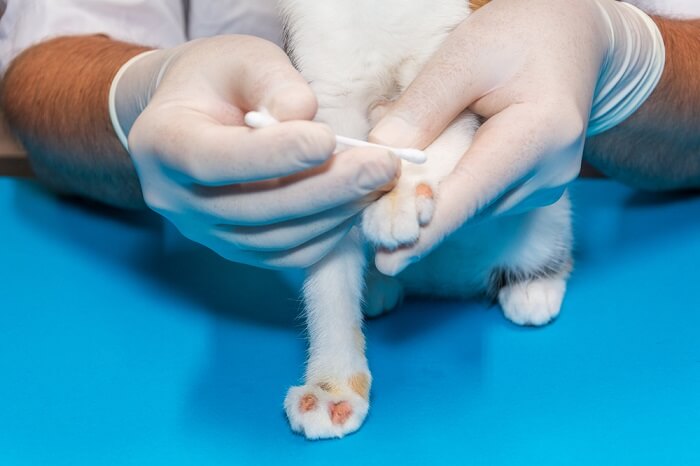
Solutions for treating fungal infections in cats include skin ointments containing antifungal medication, antifugal shampoos and oral medication.
The primary treatment of fungal infections is antifungal medication. A wide range of anti fungal drugs are available, and the correct choice depends on the type of fungal infection and the part of the body affected.
Ringworm, the most common fungal infection, is treated as follows:
- Skin ointments containing antifungal medication
- Shampoos containing antifungal medication
- Oral medication such as itraconazole
Monitoring and Prognosis
Fungal infections can take weeks or months to resolve, so you need to continue to liaise with your veterinarian until they are satisfied that the issue is fully sorted. Relapses are common.
Conclusion
Many types of fungal infections may be seen in cats, affecting different parts of the body. Skin fungal infections (so-called “ringworm”) are the most common. Close liaison with your veterinary surgeon is the best way to tackle any suspected fungal infection.
Frequently Asked Questions
How do you treat fungal infection in cats?
Treatment depends on the precise nature and location of the fungal infection: your veterinarian will advise you on the best answer, but options include topical (eg shampoos,ointments) and systemic (e.g. oral).
How do you know if your cat has fungal infection?
This is a diagnosis that needs to be made by your veterinarian: the most that you can do on your own is to suspect a fungal infection based on the signs shown by your cat.
What kills fungus on cats?
Specific anti-fungal medication, licensed to be used in cats, is the best option. This can be topical (ointments, creams, shampoos) or systemic (usually oral liquid or tablets).
How can I treat my cats fungal infection at home?
You need to work with your veterinarian to find the best treatment method: this may include shampoos and ointments applied at home, as well as tablets or liquid given orally.






